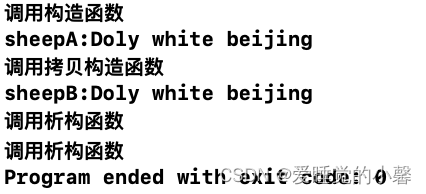浅拷贝:普通类型的成员变量
深拷贝:成员变量是不是有指针类型,数组类型或者其他类的引用的时候,深拷贝。
代码演示:
#define _CRT_SECURE_NO_WARNINGS
#include <iostream>
#include <string.h>
using namespace std;
class Sheep //定义绵羊类Sheep
{
public:
Sheep(string name,string color,const char*home); //声明带参数构造函数
Sheep(const Sheep& another); //声明拷贝构造函数
void show(); //声明普通成员函数
~Sheep(); //声明析构函数
private:
string _name; //声明表示绵羊名字的成员变量
string _color; //声明表示绵羊颜色的成员变量
char* _home; //声明表示绵羊家的成员变量
};
Sheep::Sheep(string name, string color,const char* home)
{
cout<<"调用构造函数"<<endl;
_name=name;
_color=color;
//为指针成员home分配空间,将形参home的内容复制到_home指向的空间
long len=strlen(home)+1;
_home=new char[len];
memset(_home,0,len);
strcpy(_home,home);
}
Sheep::Sheep(const Sheep& another) //类外实现拷贝构造函数
{
cout<<"调用拷贝构造函数"<<endl;
_name=another._name;
_color=another._color;
_home=another._home; //浅拷贝
}
void Sheep::show()
{
cout<<_name<<" "<<_color<<" "<<_home<<endl;
}
Sheep::~Sheep()
{
cout<<"调用析构函数"<<endl;
if(_home!=NULL){
//delete _home; //此处指针释放不成功,不知道为啥,所以先注释,先放一下。
}
}
int main()
{
const char *p = "beijing";
Sheep sheepA("Doly","white",p);
cout<<"sheepA:";
sheepA.show();
Sheep sheepB(sheepA); //使用sheepA初始化新对象sheepB
cout<<"sheepB:";
sheepB.show();
return 0;
}
运行结果:
